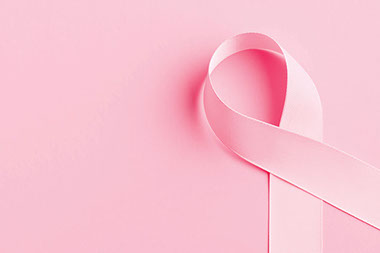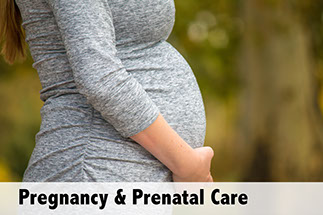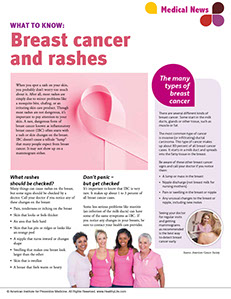MEDICAL NEWS
Breast cancer and rashes

When you spot a rash on your skin, you probably don’t worry too much about it. After all, most rashes are simply due to minor problems like a mosquito bite, chafing, or an irritating skin care product. Though most rashes are not dangerous, it’s important to pay attention to your skin. A rare, dangerous form of breast cancer known as inflammatory breast cancer (IBC) often starts with a rash or skin changes on the breast. IBC doesn’t cause a telltale “lump” that many people expect from breast cancer. It may not show up on a mammogram either.
What rashes should be checked?
Many things can cause rashes on the breast, but some signs should be checked by a doctor. Call your doctor if you notice any of these changes on the breast:
• Pain, tenderness or itching on the breast
• Skin that looks or feels thicker
• An area that feels hard
• Skin that has pits or ridges or looks like an orange peel
• A nipple that turns inward or changes shape
• Swelling that makes one breast look larger than the other
• Skin that is swollen
• A breast that feels warm or heavy
Don’t panic – but get checked
It’s important to know that IBC is very rare. It makes up about 1 to 3 percent of all breast cancer cases.
Some less serious problems like mastitis (an infection of the milk ducts) can have some of the same symptoms as IBC. If you notice any changes in your breasts, be sure to contact your health care provider.
The many types of breast cancer
There are several different kinds of breast cancer. Some start in the milk ducts, glands or other tissue, such as muscle or fat.
The most common type of cancer is invasive (or infiltrating) ductal carcinoma. This type of cancer makes up about 80 percent of all breast cancer cases. It starts in a milk duct and spreads into the fatty tissue in the breast.
Be aware of these other breast cancer signs and call your doctor if you notice them:
• A lump or mass in the breast
• Nipple discharge (not breast milk for nursing mothers)
• Pain or swelling in the breast or nipple
• Any unusual changes to the breast or nipple, including new moles
Seeing your doctor for regular visits and getting mammograms as recommended is the best way to detect breast cancer early.
Source: American Cancer Society

Download an offline pdf file.
MEDICAL NEWS ARTICLES
<
>
2021 © American Institute for Preventive Medicine - All Rights Reserved. Disclaimer | www.HealthyLife.com








